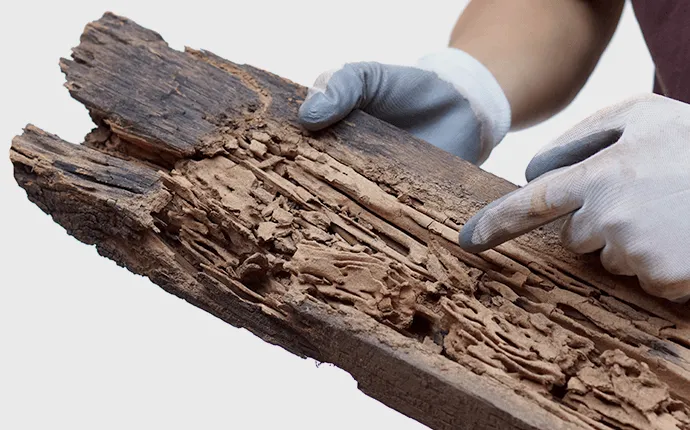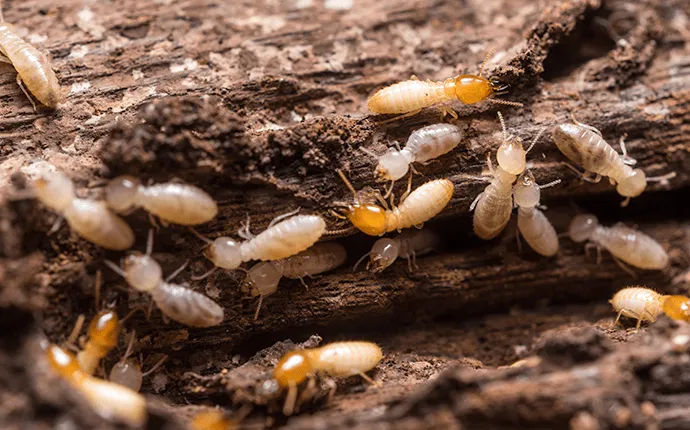
What Does Termite Damage Look Like In North Carolina Homes
We've reviewed what early termite prevention before summer can do for your home. Now, let's look at some of the warning signs you'll be able to see all year long. This guide will help understand what does termite damage look like in your home and what to look for in your yard.
The last thing you want to do is miss termite damage when you see it. Subterranean termites cost U.S. property owners billions each year. Here's what you need to know.


Early Signs of Termite Damage Inside Your Home
Termites don't destroy your home over a weekend. It happens over time, especially in the summer when the temperatures are ideal for termite activity. So, what does termite damage look like in the early stages? Some of the damage you may see can be:
Damaged Belongings
Termites don't just eat wood. They will eat anything that has cellulose in it. Inside your home, this might be a pile of clothing, books, cardboard, etc. If termites feed on these materials, they will enter from a wall or floor. They won't chew their way out of the wall and walk across the floor to do it.
In some cases, they might establish mud tubes to bridge a gap. It is important to look for these as well. If termites are damaging your belongings, you're going to have holes in those items, but this damage doesn't have a consistent appearance that we could describe.
Bubbling Paint or Wallpaper
Although worker termites don't have compound eyes and are considered blind, they are sensitive to light and will avoid it as much as possible. For this reason, they will often feed on wood until they get right up to the paint, wallpaper, or simply (the light) outside of their tunnels. This is the theory at least. Entomologists don't know for sure. But this behavior will make your wall surfaces begin to bubble where termites are busy feeding.
Dents in Drywall
While subterranean termites prefer soft wood or wood that has been softened by moisture, they can and do feed on hardwood. If they feed on baseboards or window and door frames, you may begin to see honeycomb-like dents begin to form on the surface. Take something hard and bang it on that wood. If there are termite tunnels behind there, it should sound hollow. And, if there are enough termites focused in the one area, you may begin to hear a rustling noise. This is the sound of soldier termites banging their heads against tunnel walls to warn worker termites of danger.
Signs of Severe Termite Damage
What does termite damage look like when it's past the early stages? If termites are not caught early, damage can snowball fast and have a cascading effect. Support timbers damaged by termites can weaken and cause the structural frame of a home to begin warping. This is when you'll begin to see the late stages of termite damage:
- Doors and windows cease to function properly. When the frame warps, doors and windows can begin to stick, or open and close freely. This may have you sticking a piece of wood in your window to prop it open.
- Floors sink. Houses can settle, so this isn't always a sign of termites, but when a floor begins to sink down and you notice bubbling, it is definitely a bad combination.
- Ceilings dip. If your ceiling begins to look like it is being damaged by water, it might be termites.
Termite Damage Outside
When termites come to feed on your home, they are likely to feed on other objects in your yard. Their preference is moist wood but they can feed on anything that has cellulose in it.
- If you have a garden, don't be surprised if termites feed on some of your veggies. They have a particular affinity for corn.
- If you have a stump or a log, this will definitely be a target for worker termites. You'll need to chop off a chunk and look for tiny pale insects crawling around inside.
- If you have a fence, termites may feed on the posts. You'll need to dig into the soil to find them.
- If you have a shed or outbuilding that has wood that touches the ground, you may see the wood eaten away at the soil level.
- If you have shaded areas around your home and wood that touches the soil in these areas, you may see termite damage near the ground. Look behind bushes and under external structures.
Subterranean termites are extremely destructive. When damage appears, reach out to the termite control professionals at A-1 Pest Control for immediate assistance.
A-1 Termite Control Services in North Carolina
If you need to get rid of termites in your home, A-1 Termite Control can help. We'll inspect your property for signs of a termite infestation and the extent of your termite damage. We'll then provide you with a termite control quote. We have offices located in Lenoir, Hickory, Mooresville, West Jefferson, and Blowing Rock, but we provide services to all of Western North Carolina.
Get in touch with us by calling us at 828-481-9140 or filling out the form below to get your termite control estimate today!
